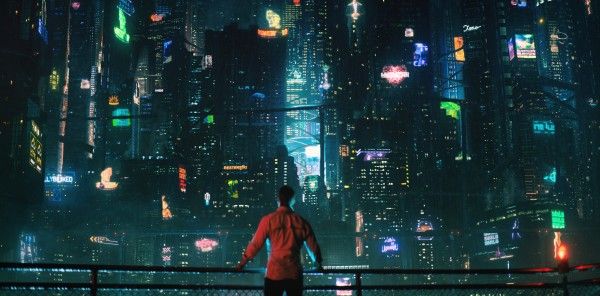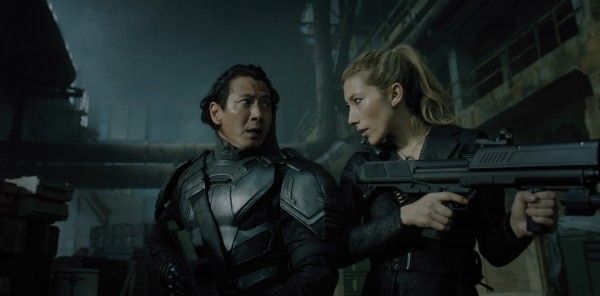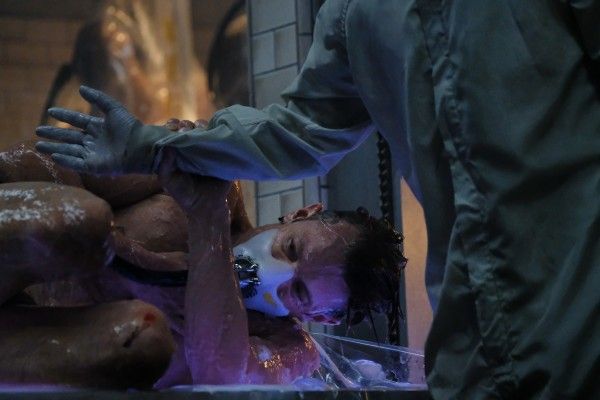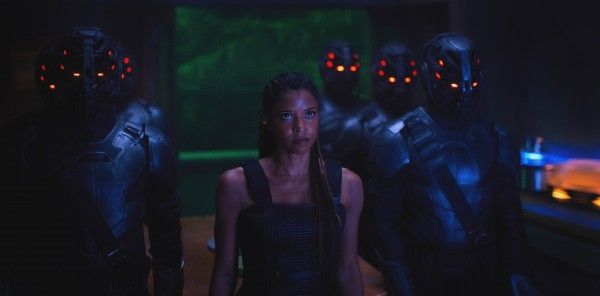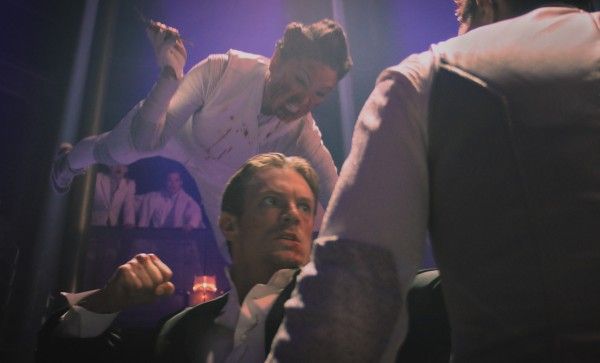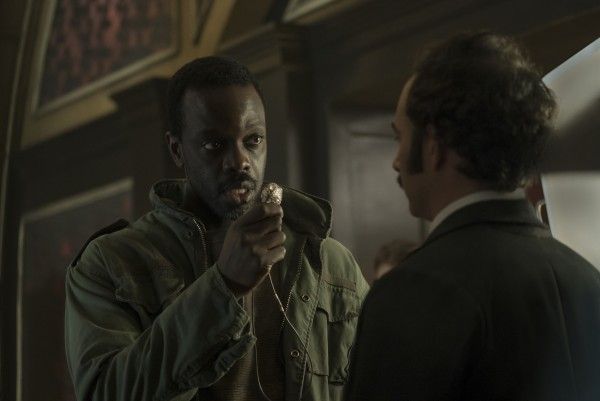The earliest criticisms of Altered Carbon focused on perceived whitewashing, excessive female nudity, and a price tag rumored to be around $7 million – and not without good reason. The main character, played by Joel Kinnaman, is a former Asian revolutionary who is given a new “sleeve” – a nifty way of saying “body” – thanks to a procedure that’s become as normal as a doctor’s visit. A digital disk, called a “stack,” holds all of your memories and personal history on it and can be easily inserted into a new sleeve when the old sleeve dies off.
It’s enough to raise an eyebrow but considering the plot’s myriad contrivances, it at least blends in with the narrative’s logic. And that’s not even considering the fact that for $7 million an episode, Netflix could have funded 10 movies on the level of Get Out, seven on the level of Split, or three on the level of Girls Trip. As frustrating and groaningly familiar as all of this is, however, what makes Altered Carbon such an exhausting and insubstantial experience has almost nothing to do with the politics of the show’s casting or funding, especially as it learns the wrong lessons from others sci-fi films and TV series. Fair warning: spoilers ahead.
Kinnaman’s character, Takeshi Kovacs, is played in his earlier forms by Will Yun Lee and Byron Mann, and both are featured prominently in flashbacks and the series’ pilot. Aside from Takeshi, the main figures in the series are Lieutenant Kristin Ortega (Martha Higareda), Ato Essandoh’s Vernon Elliot, revolutionary leader Quelle (Renee Elise Goldsberry), and James Purefoy as the extravagantly wealthy Bancroft, who hires Kovacs to solve his murder, which was originally thought to be a suicide. In terms of racial diversity, Altered Carbon at least has the veneer right, both in the main cast and in secondary characters, even if it doesn’t show a similar level of variance in terms of sexuality. It’s also fair to say that the series has a minimal interest in the national or racial backgrounds of these characters, explained away by a futuristic, wholly globalized world where the wealthy can go planet-hopping and the poor and middle-class are left to wander Bay City, a ground-level metropolis that is all but identical to that of Blade Runner. Nevertheless, Altered Carbon gets the visage right, unless your sense of diversity hinges on the lead being played by anyone but a white male. If so, fair enough.
One of the few things that the series, created by Laeta Kalogridis, has going for it is the dense, effects-laden visual world that her creative team has put together here. If one can look beyond the aping of Ridley Scott’s overall aesthetic, DPs Martin Ahlgren and Neville Kidd, production designer Carey Meyer, set decorator Lin MacDonald, costume designers, Ann Foley and Christina Wada, art directors Harrison Yurkiw and Chris Beach, and the entire effects team create a wondrous landscape for the characters to fight and talk within. Textures shift between different experiences – VR simulations, impossible cameras, an AI underworld, etc. – and neon lights set the darkness ablaze with the promise and damnation of cheap scintillation. If you emptied the world out of all characters, it would make for a splendid sleep-screen for your Apple TV. Unfortunately, that’s not the case here.
The creator’s vision of the world, of its services, practices, and technological advances, speaks for itself for the most part, and remains best when allowed to do so. The physical fights are often exhilarating, though the editing trades urgency for clarity, and the uncanny elements of the world – a zero-gravity fight at Bancroft’s home sticks out – are wonders to behold when not frantically and inelegantly explained. Other elements, such as the oozy procedure of rebirthing with a new sleeve or the virtual-reality torture sequence between Kovacs and a Russian bruiser, are so plainly lifted from The Matrix that it becomes difficult to take anything seriously, including a man getting his legs burned off.
The sad truth is that Altered Carbon is over-explaining everything about the world of Bay City and this dystopian planet all the way through its ridiculous conclusion. When Poe (Chris Conner), the AI that manages the hotel where Kovacs stays, is first introduced, its clear that he’s clingy and somewhat obsessed with his new boarder. And yet before we even meet Poe, there’s an exchange where Kovacs is reminded that AIs who run hotels have a tendency to become clingy with their guests. The explanatory dialogue that goes into detailing the differences and capabilities of cloning, sleeve technology, stacks, back-ups, and innumerable other breakthroughs in immortality (or simple leisure) is dense and convoluted to the point of engendering ambivalence. That might be sufferable if all this innocuous and empty talk didn’t make up a majority of the series’ runtime.
To be fair to Kalogridis and her writing team, such explanations are always required to some degree. Even the well-regarded Black Mirror hinges on more cannily deployed exposition to explain its various worlds. And that’s not the only thing that connects the two series. Both Black Mirror and Altered Carbon offer almost exclusively cynical, conservative visions of the future of technology, exploring worlds absent of any kind of joy or humanistic passion. Where Black Mirror occasionally finds the time to express small behavioral details or a sense of a character’s antic inner life, however, the characters in Altered Carbon are completely hollow, representative of one-dimensional moods rather than of rich, complex people addled by past lives. Everything that these figures say or do is hooked to the extraordinarily convoluted plot.
This is not a problem in casting. All the performers, from Kinnaman and Higerada to Waleed Zuaiter (as Ortega's partner) and an exceptional Matt Frewer (playing a nefarious AI) consistently give all the long-form explanations, one-liners, and noir-tinged exchanges energy and a distinct timbre, like a catchy song with lyrics that make you embarrassed to live. Kinnaman is doubly cursed in that he must also deliver numerous portentous intros made up of risibly faux-poetic musings about identity, salvation, and rebellion. The fact that the series hews closely to the source material of the same name by Richard K. Morgan could be partially to blame for this, but no matter what anyone says about the necessity of playing to an established fanbase, the creators were under exactly no obligation to copy lines verbatim, let alone attempt to dutifully adapt a 337-page paperback into somewhere around 10 hours of TV.
A sizable amount of those 10-or-so hours are made up of scenes where women appear completely naked. The entire series’ view of sex is no picnic on the whole. All four female leads are seen nude, and Dichen Lachman is the focus of a sequence where she plays a legion of clones going after Ortega in their birthday suits. To balance this out, there are a handful of floppy penises on display, but there’s a clear rush to cut away from male frontal where the female nudity is extensive and unrelenting. It doesn’t add anything, and it makes the series’ tendency to portray all sex as violent, dark, aggressive, and severely lacking in anything like joy. It always seems like the participants just have to do it, an act done out of critical necessity rather than attraction or just plain boredom.
It’s similar to HBO’s Westworld in this, which has a similarly noxious and problematic view of sex. Both are also narratives bent on the uprising of a servant class against wealthy oppressors, and while they both make allusions to being about everything from religion and sex to violence and identity, neither offer insights beyond simplistic cynicism about human nature. Black Mirror is more often about the failure of rebellion rather than triumphs, but it similarly postures as being intellectual about the future of societal habits while offering prickly witticisms as profound answers. Even Humans, an overall excellent series, pivots on a vaguely defined societal uprising that is presented with little more detail or nuance beyond a goal of even vaguer freedom.
What makes all this so irritating is the promise of Altered Carbon, in both thematic material and imagery. In the few instances when the show allows itself to be in the present, rather than discussing or depicting the past or brooding about the future, it’s thrilling to behold. The series finally breaks down though in the last few episodes into a rapid-fire, egregious amount of twists and power-reversals, a brazen bid to stoke tension that comes off as desperate and unthinking. Similar tension is barely palpable to the noir-style detective-story beats of Kovacs’ investigation into Bancroft’s would-be killer, which is rendered absolutely meaningless by the time the series becomes centered on dysfunctional siblings.
The more fascinating subplot involves Vernon’s relationship with his murdered daughter, Lizzie (Hayley Law), whose stack is just barely intact after she was attacked. He visits her in a grainy, fried virtual realm constantly, and after awhile, she comes under the tutelage of Poe, a master of weaponry. There was a chance here to genuinely confront how technology both inflames and sooths traumatic grief, but she’s turned into a bold ass-kicker who essentially magically appears to save the day for Ortega, Kovacs, and her parents. It’s a ludicrous if entertaining sequence to watch, and it underlines a growing, worrying tendency in TV television to get wrapped up in premise and world-building rather than capture full, complex characters in unpredictable moments and quiet revelations of personality or behavior. Altered Carbon doesn’t bother with much of that, and instead finds solace and uncomplicated entertainment value, like so many other science-fiction programs, in unending strife, gruesome death, and war.


